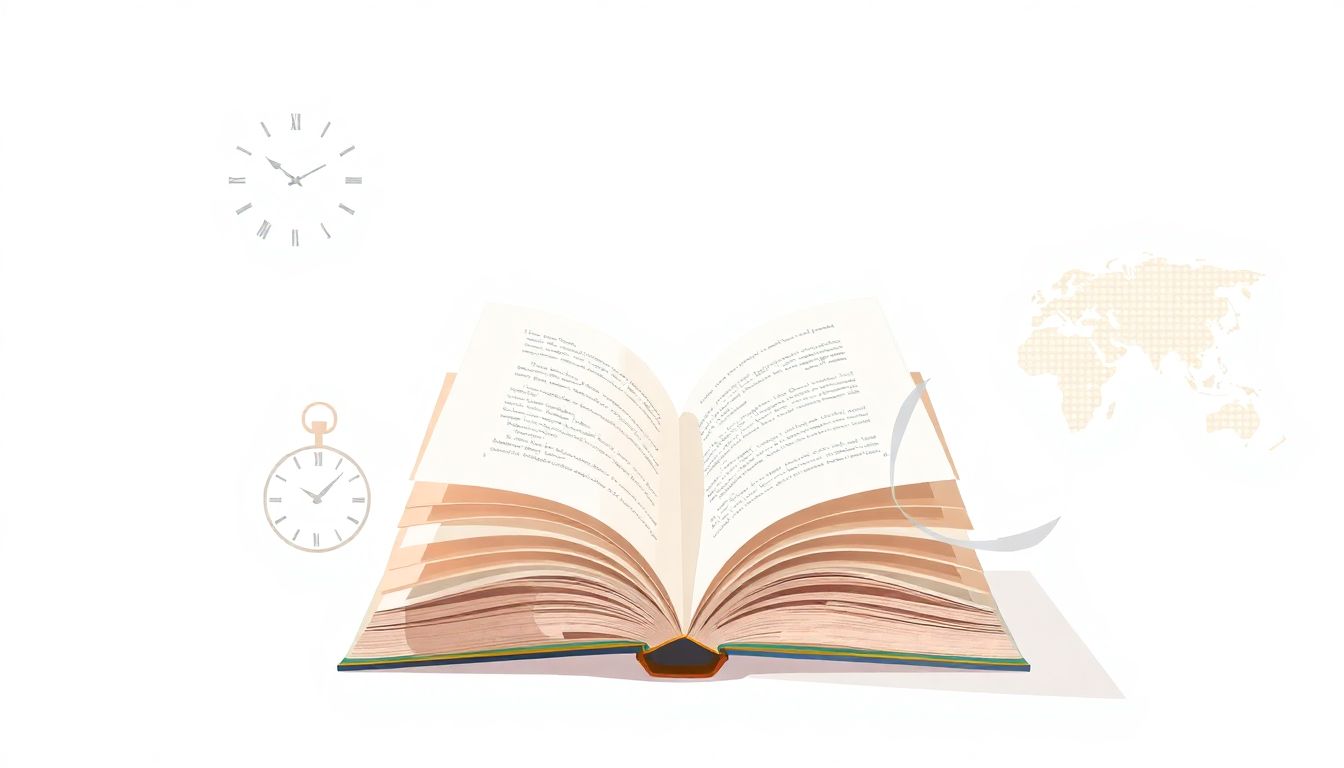You’re probably thinking, “Book translation? Sounds pricey and complicated.” And you’re totally right—figuring out how much it’s gonna cost, what kind of service to use, and how long it’ll take can feel tricky.
But stick with me! By the end of this guide, you’ll be able to easily understand pricing options, pick the right kind of translation service, set a realistic timeline (and even rush things if you’re on a tight schedule), match your exact genre and language needs, and finally find that perfect translator.
Ready to get started? Let’s jump right in!
Key Takeaways
- Expect translation costs generally in the $0.06-$0.30 per word range; costs rise with uncommon languages, complex content, experienced translators, and tight deadlines.
- Freelancers are budget-friendly but quality varies; translation agencies provide reliable quality controls at higher rates; machine translation alone won’t cut it without human editing.
- Standard translation speed is 2,000-3,000 words daily; a 60,000-word book usually takes 6–8 weeks total. Rush jobs, involving multiple translators, typically cost 20–50% more.
- Target translators experienced in your genre—fiction requires emotional nuances; academic books need familiarity with technical language.
- Pick translators carefully with this checklist: genre experience, good references, translation samples, clear communication, native speakers, transparent contracts, proofreading included.

Step 1: Understand Book Translation Costs and Pricing Options
If you’re planning to translate your book, the first thing you probably ask yourself is, “How much is this going to cost me?” Fair enough—money is usually the first hurdle people run into when thinking about book translation.
Generally, book translation services are priced per word, per page, or per project. Rates can vary widely, usually between $0.06 and $0.30 per word, depending on several factors like the language pair, topic complexity, and urgency. So, a 60,000-word novel could cost you between $3,600 and $18,000 (yes, that’s quite a spread!).
Here’s what can affect that cost:
- Language pair: Translating to common languages like Spanish or French can be cheaper than more specialized languages like Japanese or Swedish. Simply put, more exotic equals pricier.
- Translator’s experience: Hiring beginners or freelancers on self-publishing platforms like Amazon KDP can keep costs down, but seasoned translators with proven backgrounds generally mean higher prices and better quality.
- Complexity of the text: Fiction written in everyday language tends to be cheaper compared to specialized non-fiction books or academic texts that are dense and jargon-heavy.
- Deadlines and urgency: Need it yesterday? Rush jobs often have premium rates, meaning quicker turnarounds equal higher costs.
A pro-tip for budgeting translation: ask upfront if the quoted rate includes proofreading and editing because some translation services separate these into different fees. You’d be amazed how quickly costs pile up if you’re not careful.
Step 2: Compare Different Types of Translation Services for Books
So now you’re aware that book translation is necessary, but what kind of service should you look for? Typically, there are three main types you might consider:
- Freelance Translators: Probably the go-to option if you don’t have a massive budget. Websites like Upwork or Fiverr are popular examples—but here’s a caution: quality varies greatly, and low-cost translators might mean additional editing expenses later.
- Translation Agencies: Agencies offer you translators, editors, proofreaders, and usually have a project manager who takes away a ton of your headache (saving some Tylenol money, at least!). However, they come at a higher cost, typically justified by providing better quality control and consistency.
- Machine Translation with Post-editing Services: Tools like DeepL or Google Translate might seem easy (and tempting because they’re cheap!), but there’s a catch. AI translations often sound weird to native speakers—think clumsy idioms, awkward phrases, and occasional hilarious mistakes (“My hovercraft is full of eels,” anyone?). In short, even after machine translation, you’ll need human post-editing.
The takeaway? Consider your goals carefully before choosing:
- Quick promo or internal documents might work with machine translation and editing.
- Full-length novels or memoirs intended for widespread publication? Choose a human translator via agency route or at least a reputable, vetted freelancer.
Step 3: Determine Timelines for Book Translation and Rush Options
How long does it take to translate a book? Short answer: it depends. But you probably guessed that already, right? Let’s get real—translation isn’t an overnight job, especially for full-length manuscripts.
Most experienced translators handle around 2,000 to 3,000 words per day comfortably. Using easy math, your 60,000-word novel could take around 20 to 30 working days. Add to that a couple of weeks for proofreading, editing, and revisions—realistically you’re looking at about six to eight weeks to get everything polished and ready.
But what if you’re under pressure and need it fast? Many translation companies offer rush or expedited services to speed things up, typically by assigning multiple translators to one book project. Be warned, though: rush jobs usually cost at least 20-50% more due to overtime and coordination efforts. So ask yourself: how much does speed matter versus budget?
Here’s a helpful tip to speed up your process without emptying your wallet—make your manuscript as clean as possible before translation begins. Clear formatting, removing unnecessary text or repetitions, and double-checking your original document with a trustworthy software (check out this comparison of Autocrit vs ProwritingAid) can save you headaches, precious time, and extra editing efforts during translation.

Step 4: Identify Specific Translation Needs Based on Book Genre and Language
So you’ve made it this far, and now you’re wondering, “Does genre really matter when translating a book?” Short answer: absolutely—it changes everything from price and timelines to picking the most suitable translator.
For instance, fiction, like romance novels or horror stories, often requires translators who capture emotions, humor, and cultural nuances in the target language.
On the flip side, translating non-fiction books, especially academic texts or scientific materials, means choosing someone familiar with technical jargon and terminology.
The same goes for kids’ book translations, where simplicity, playful language, and readability for young readers matter most.
Also, think about the language into which you’re translating. Translating English novels into widely spoken languages like Spanish or German usually costs less and has a shorter turnaround.
But translating to more niche or complex languages—say Czech, Chinese, or Finnish—tends to be pricier and slower, because fewer qualified translators handle those languages.
One helpful strategy is to check bestseller lists in the target country (e.g., Amazon or local bookstores), which helps determine if your genre is currently popular there and worth translating.
Finally, if unsure about which languages to target, you could try translating teaser chapters or promotional materials first to test demand before investing in the full book translation.
Step 5: Select the Right Book Translation Provider (Checklist Included)
Alright, friend, you’ve understood costs, services, and genres—what next? Choosing the perfect translation partner is often where a lot of writers get stuck.
Here’s a practical checklist that’ll help you pick wisely without pulling your hair out:
- Experience and Specialization: Ask about their previous book translation experience (bonus points if they have specific experience in your book’s genre).
- References & Reviews: Don’t shy away—ask for references or look for online reviews on reliable websites or LinkedIn to get insights from past clients.
- Translation Samples: Always request sample translations (around 500-1,000 words), especially if it’s your first time working with a translator or agency.
- Communication: Clear, prompt, and friendly communication is critical—make sure your provider answers your questions without delay (or you might go crazy waiting!).
- Native Speakers Only: Make sure translations are handled only by native speakers of the target language to maintain natural style and cultural accuracy.
- Contracts and NDAs: Look for transparent contracts that define deadlines, fees, and revision terms; an NDA can protect your manuscript content and ideas.
- Additional Services Included: Check if proofreading and editing are bundled—it might be cost-effective and save headaches later on.
If you still feel overwhelmed by options, consider hiring a beta reader familiar with your target language and book genre to review translation samples; here’s how to work effectively with a beta reader.
Lastly, trust your gut—if a service provider seems too cheap to be true or is vague on details, it probably isn’t worth the risk.
Bonus Tips: Leveraging Trends in Translation & Localization (Stats Included)
Did you know the global translation market size is projected to hit over $45 billion by 2025? This tells you one big thing: demand for translations and localized content isn’t slowing down anytime soon.
One interesting fact: 76% of online buyers prefer purchasing products with descriptions in their native language (source: GALA).
What does this mean for you?
First, invest in translating promotional materials like your book cover, synopsis, author bio, and even author website, helping improve discoverability.
You could also test shorter content pieces in other languages, for instance transforming short stories or creative materials like winter writing prompts, to see if there’s demand before translating the complete work.
Also, a recent report highlighted consumers rank language as more important than price (56%) when it comes to making buying decisions—clearly, language plays a huge role in purchasing behavior.
Lastly, remember tech is improving daily, but human translators are essential; machine translations still struggle big-time with idiomatic expressions and cultural nuances. Use AI only as an assistant, not a standalone translator.
Keep these tips handy, and you’ll translate your book without regrets or spending unnecessary cash. Happy translating!
FAQs
Book translation costs depend on the length, complexity, and target languages. Average rates range from $0.08-$0.20 per word for standard translations and rise for specialized genres or technical content. Always request detailed quotes for your particular project.
Popular book translation service types include basic translation, literary translation focused on style and storytelling, proofreading and editing after translation, and localization tailored to cultural contexts. Selecting the appropriate service ensures accurate communication for your readers.
Translation timelines vary significantly with book length, complexity, and the translator’s workload. Typically, translating a full-length novel can take 2-4 months. If deadlines are tighter, many providers offer rush services that deliver translations more quickly at an extra cost.
Different genres demand varying vocabulary, stylistic nuances, and cultural sensitivities. Translating a fiction novel involves creativity and literary adaptation, whereas a scientific book requires precise terminology and specialized knowledge, making customized translation strategies necessary.
